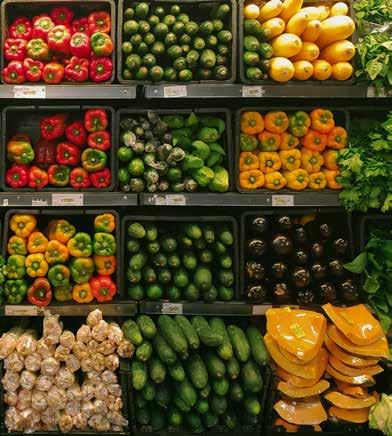
10 minute read
Commercially minded
More than a quarter of HNWIs are looking to increase their commercial property holdings, according to our HNW Pulse Survey. Flora Harley asked our global experts for insight into how HNWIs are investing in their markets, plus their top tips for 2023
Whether in a private capacity or through an established family office, HNWIs are commanding a growing slice of commercial property market activity (see page 14). For seasoned investors the opportunities may appear clear, while others see high barriers to entry. In fact, the average level of investment required from private individuals is often smaller than for big institutional players. HNWI transactions averaged US$18 million over the past decade, compared with US$40 million for
Advertisement
“HNWI transactions averaged US$18 million over the past decade” institutions, according to analysis of RCA data. Among our HNW Pulse Survey respondents, 54% of those planning to invest are seeking opportunities under US$1 million and one in ten will be investing US$20 million or more. Knowing what options are available at differing price points will be critical to success. We gathered our global experts to explore the various ways in which wealthy individuals are investing in commercial property globally and to share their top tips.
ALEX JAMES Head of Private Client Advisory, UK
What trends are you seeing among wealthy investors in the UK?
How much those considering investing in commercial property say they are likely to invest
Private clients are typically investing anywhere from £5 million to £25 million on average. In the long term, cash rich private investors have been taking advantage of repricing, currency benefits and less competition from larger institutions to target the UK, among other locations. They have been opportunistic across a diverse range of sectors and risk profiles throughout 2022. As a result, we saw an increase in demand for offices, retail and hospitality which offer post-Covid recovery opportunities along with strong fundamentals.
What are the opportunities for 2023 and beyond?
Supermarkets and logistics, especially larger lots with good covenants. The fundamentals are still strong and tie in with the supply chain for both online and in-person consumers. Online sales are anticipated to grow by an additional £31 billion by 2026. Over the next five years, this could result in additional demand for roughly 10 million sq ft of last-mile fulfilment space. Then there are the living sectors, which are more defensive. Student housing has favourable demographics, and we are likely to see greater international demand following the lifting of

Covid-19 travel restrictions. A record £7.2 billion was invested in purpose-built student accommodation in 2022 in the UK, a 62% year-on-year rise.
What are your top tips for those looking to invest?
Energy and operational costs have been a major issue throughout 2022 and highlighted the importance of ESG throughout the property market. Energy efficiency will be under increasing scrutiny: our research previously demonstrated the premium attached to greenrated buildings, but this may expand given upcoming regulations and historically high energy costs.
RESIDENTIAL INVESTMENT HARRISON COLLINS Residential Development Capital Markets,
UK
What trends are you seeing among wealthy investors looking to the living sectors?
First-time investors tend to start small to get a general feel for the transactional process before committing larger sums of capital. In the past year we have sold assets to HNWIs or family offices ranging from £2.5 million to £40 million.
Where is the added value and what are the opportunities for 2023 and beyond?
The rental market was extremely strong in 2022 and is expected to continue to grow in 2023. There is a natural lag in capturing rental growth with 12-month tenancies, i.e. those that commenced or renewed in Q1 2022 failed to capture the growth in the later part of the year. This presents an opportunity for investors acquiring residential assets this year, who can expect to see a significant reversion in their headline rents.
Investors are looking to balance their portfolios between core London assets and regional investments. Regional assets offer more attractive returns (yields tend to be 75–100 basis points higher) and a lower entry point, with the average price per unit being considerably less.
Some would-be vendors have been discouraged from divesting by the economic and political backdrop of the second half of 2022. This lack of stock, paired with continued demand for residential investments, has resulted in good competition which has underpinned pricing.
What are your top tips?
It is crucial for incoming investors to have efficient management structures in place. Owning residential investment property requires proactive asset management and all investors need to be aware of the relevant statutory compliance, legislative and best practice issues.
ALEXANDRE OLIVIER Capital Markets, France ANDREW LOVE Head of ME Capital Markets & OLSS, Middle East
What trends are you seeing among wealthy investors in France?
HNWI investors are able to position themselves on a wide range of investments, whether in terms of risk level (from value-added to core) or type of asset (e.g. office or residential). In the past year HNWIs and family offices have been active both with transactions under €10 million and landmark investments well over €100 million.
Where are the opportunities for 2023 and what are your top tips?
In the context of tightening financial conditions, the ability of HNW investors to exploit their equity resources and mitigate the impact of debt should be a source of opportunity. Moreover, the attractiveness of the Paris market in the luxury retail and residential segments should continue to appeal.
What trends are you seeing among wealthy investors across the Middle East?
Private investors can start as low as US$2 million to US$3 million or go up to US$200 million. Typically, the sweet spot is around US$20 million to US$50 million. We have seen an array of investors, with the most active coming from the Emirates, India and the UK.
Where are the opportunities for 2023 and beyond?
Prime residential has been the best performing sector (see page 32).
HNWIs have sought out mixed-use single owned towers or compounds of villas which can be broken up to sell individually. We have also seen HNWIs speculatively build good quality warehouses, take on the leasing risk and then sell to funds. More recently, we have seen a similar play in the co-living and data centre sectors, which are emerging asset classes here.

What are your top tips?
If purchasing to hold, due diligence and market assessment are critical. The build quality and maintenance of assets is generally poor compared with Europe and that can lead to greater capital expenditure than anticipated, limiting returns.
What can wealthy investors expect to see when investing in farmland?
For wealthy investors there is often a residential amenity element to agricultural investments. When looking at a basic farmland investment, in the UK the entry point would be around £1 million for 100 acres. For scale, the minimum size of a commercial farm is 1,000 acres, or around £10 million. In terms of forestry land, around £1 million would be required for a modest investment.
Where is the added value and what are the biggest opportunities for 2023 and beyond?
Natural capital, nature-based solutions, climate change, biodiversity loss – all have come to the fore over recent years and farmland is key to delivering on targets globally. The commitments
AUSTRALIAN FARMLAND ANDREW BLAKE
Head of Regional Capital & Agribusiness, Australia
The Australian government has a plan to increase the value of its agricultural sector from A$60 billion to A$100 billion by 2030. This requires improvement of landscape functions, provision of livestock with high welfare standards, maintaining a powerful social licence and a biodiversity programme. Australia has a unique opportunity to leverage its location, efficient logistics networks and agtech to collaborate and make its agriculture industry a leader in the global market. We anticipate exports will increase significantly within the next six to seven years, with premium food products forecast to grow by 55%.
Producers of sheep meat, almonds, wool, lentils and wine stand to benefit the most from increased access to the Indian market when the AustraliaIndia Economic Cooperation and Trade Agreement (AI-ECTA) comes into force in early 2023. The AustraliaUnited Kingdom Free Trade Agreement (A-UKFTA) will also prove advantageous once it takes effect later this year.
from COP15 in Montreal last year indicate greater value to come. Some of the biggest opportunities will be in locations where land has been treated poorly, offering the greatest scope to boost natural capital values and carbon credit opportunities.
The other area is food security. This was highlighted by global food shortages and price hikes in 2022 following Russia’s invasion of Ukraine, which accounts for 42% of the world’s sunflower oil exports and 10% of wheat. UK Prime Minister Rishi Sunak has committed to introducing a government food security target this year.
What are your top tips? Have a clear strategy. How will you manage the land? What’s the objective and time frame? How will you finance it and who will run it?
Farmland can be relatively cheap in developing nations, but you need a local management team that you can trust if you don’t live there. The other consideration is environmental and climatic conditions. In the 2021 edition of The Wealth Report our Analytics team mapped predicted climate shifts to pinpoint parts of the world likely to see the biggest impacts on their agricultural sectors. This information is key for longerterm investing.
01. Triumphant – Paris’s luxury retail market is appealing
02. High life – Living sectors are a top target
03. Turning tide – Renewable energy is in the spotlight
04. Down under – Australia’s agricultural sector opens up


What trends are you seeing among wealthy investors looking indirectly at property investment through debt?
Debt funds backed by private wealth tend to play in the smaller ticket lending space, with loans ranging from £5 million to £15 million per transaction. That said, we have also seen some funds issuing loans as large as £200 million.
HNWIs in this space will typically be seeking an internal rate of return of 15%. They tend to target development or value-add opportunities where significant capital expenditure is required. We have also seen private debt funds offer bridging facilities.
Global perspective
There is an overarching drive towards investing in debt rather than equity because it represents better value. The debt is secured above equity in legal charges and returns tend to be in the mid-double digits. That means lower risk for a slightly lower but still very healthy return.
Where are the opportunities for 2023 and beyond?
The funding gap. Loans that were provided in 2018 carried an all-in cost of around 3%: now that cost has more than doubled. There will be a wave of refinancing in 2023 where the loan amount will need to be reduced because
Our experts share their insights into what investors can expect to spend and what they will get for their money in the top five sectors of interest identified in our Attitudes Survey of interest coverage ratios. This will drive a requirement for flexible capital as not all borrowers will be able to bridge this, creating a key opportunity for private capital via debt funds. Investors can bridge the gap through debt, mezzanine financing or preferred equity.
What are your top tips?
Have a unique selling point. New capital needs to differentiate itself, whether by focusing on a particular segment – development, loans of a certain amount or in a specific geography – or sector. Something that sets you apart will help you find the right investment opportunities.
What trends are you seeing among wealthy investors in Spain?
Investors typically make single investments of between €15 million and €25 million and target assets across Europe or further afield, sometimes for currency benefits. UHNWIs in Spain tend to prefer residential, and favour city centres. If they already own beautiful homes, then many seek to move into small build-to-rent schemes. Offices have seen some sizeable transactions from private wealth in the past year and hotels remain favourable.
Where are the opportunities for 2023 and beyond?
There is a drive for diversification. We have one client who bought a hotel in central Madrid earning 3% and invested €65 million in a renewable energy plot with a yield of 9%. With its vast swathes of land and 350 days of sun a year, Spain will offer more opportunities in this sector.
What do HNWI investors need to consider when investing directly? Madrid is a European capital but is cheaper than other cities in Europe. Future potential for rental growth remains in the right locations. Irrespective of asset class, location is key for the long term. In addition, it’s worth noting that Spanish leases are typically linked to inflation so offer a real hedge.
What are your clients looking for when investing in commercial property?
This year will provide a unique opportunity for private clients looking to enter the market as rising debt costs may lead to less institutional activity. We have seen major growth in the number of family offices – around 700 at the end of 2022, a seven-fold increase since 2017. An investment of around S$10 million to S$20 million is required to set up a family office, but we are also seeing families pool resources.
Where is the added value and what are the opportunities for 2023 and beyond?
There is an opportunity to create value by selecting good assets and improving and operating them well. Operational sectors will outperform and are attractive for income security and long-term fundamentals. We expect more opportunities for overseas investors looking to partner with experienced on-ground managers as they invest heavily in management and operations platforms. Asia-Pacific will be a hotspot with milder inflation and more robust GDP growth than other regions. Markets such as Japan, Singapore and Australia are expected to be the most active: Japan for its weak currency and comparatively low interest rates; Singapore for its safe-haven reputation; and Australia for high transparency and softening prices.
What are your top tips?
BEN BURSTON Chief Economist, Australia
Buyers have realised that asset classes like government-leased offices, fast-food outlets and medical centres offer strong income security and benefit from consistent consumer demand. With economic growth forecast to slow in the near term, these types of asset remain in favour due to their defensive nature, and buyers are also anticipating long-term growth underpinned by rising land values.
Consider currency and how to hedge that position, and funding opportunities. The ability to purchase using cash enables private investors to act quickly. In the medium term they can then take on debt if required. Get the location right and be very clear about the purpose. Is it pure investment or is it income?




